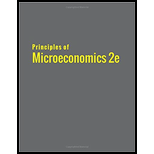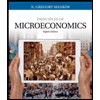
Identify the following situations as an example of a negative or a positive externality:
- You are a birder (bird watcher), and your neighbor has put up several birdhouses in the yard as well as planting trees and flowers that attract birds.
- Your neighbor paints his house a hideous color.
- Investments in private education raise your country’s standard of living.
- Trash dumped upstream flows downstream right past your home.
- Your roommate is a smoker, but you are a nonsmoker.
(a)
Whether a birder will have a positive or a negative externality is to be determined.
Answer to Problem 1SCQ
Positive Externality
Explanation of Solution
Since a birdwatcher is regarded as a third party. So, the benefit of enjoying the sweet sound of birds is regarded as a positive externality for a bird watcher.
Positive externality: is defined as a benefit that is received by a third-party as a consequence of a transaction that is economic in nature.
The Third-parties include any organisation, individual, property owner that is indirectly affected.
Negative externality: is defined as a cost that is borne by a third party as a consequence of a transaction that is economic in nature.
So, in those transactions, the producer and consumer are regarded as the first and the second parties, and the third parties include any organisation, individual, property owner that is indirectly affected.
Positive externality: is defined as a benefit that is received by a third-party as a consequence of a transaction that is economic in nature.
The Third-parties include any organisation, individual, property owner that is indirectly affected.
(b)
Whether the house painted by your neigh borer with a hideous color will have a positive or a negative externality is to be determined.
Answer to Problem 1SCQ
Negative Externality
Explanation of Solution
The house of the neighbor painted with a hideous color will have a negative externality as the hideous color is regarded as an ugly and shocking color.
Such kind of color will irritate and will not give a smoothening effect to the onlooker.
Negative externality: is defined as a cost that is borne by a third party as a consequence of a transaction that is economic in nature.
So, in those transactions, the producer and consumer are regarded as the first and the second parties, and the third parties include any organisation, individual, property owner that is indirectly affected.
Positive externality: is defined as a benefit that is received by a third-party as a consequence of a transaction that is economic in nature.
The Third-parties include any organisation, individual, property owner that is indirectly affected.
(c)
Whether the investments in private education raise the country’s standard of living will have a positive or a negative externality is to be determined.
Answer to Problem 1SCQ
Positive Externality
Explanation of Solution
The investment in private education will increase the country’s standard of living- this will be regarded as a positive externality as it will bring its benefits to the third parties.
Negative externality: is defined as a cost that is borne by a third party as a consequence of a transaction that is economic in nature.
So, in those transactions, the producer and consumer are regarded as the first and the second parties, and the third parties include any organisation, individual, property owner that is indirectly affected.
Positive externality: is defined as a benefit that is received by a third-party as a consequence of a transaction that is economic in nature.
The Third-parties include any organisation, individual, property owner that is indirectly affected.
(d)
Whether the trash dumped upstream flows downstream right past your home will have a positive or a negative externality is to be determined.
Answer to Problem 1SCQ
Negative externality.
Explanation of Solution
The trash which is dumped upstream and flows downstream right next to the house will definitely affect and the effect will be negative.
So, in this situation the effect will be negative externality.
Negative externality: is defined as a cost that is borne by a third party as a consequence of a transaction that is economic in nature.
So, in those transactions, the producer and consumer are regarded as the first and the second parties, and the third parties include any organisation, individual, property owner that is indirectly affected.
Positive externality: is defined as a benefit that is received by a third-party as a consequence of a transaction that is economic in nature.
The Third-parties include any organisation, individual, property owner that is indirectly affected.
(e)
If your roommate is a smoker and you are a non smoker will have a positive or a negative externality is to be determined.
Answer to Problem 1SCQ
Negative externality.
Explanation of Solution
If your roommate is a smoker and you are a non smoker it will definitely have a negative externality. As the non smoker will become a passive smoke that is he is not smoking directly but indirectly the affect of that smoke will affect his lungs.
So, in this situation the effect will be negative externality.
Negative externality: is defined as a cost that is borne by a third party as a consequence of a transaction that is economic in nature.
So, in those transactions, the producer and consumer are regarded as the first and the second parties, and the third parties include any organisation, individual, property owner that is indirectly affected.
Positive externality: is defined as a benefit that is received by a third-party as a consequence of a transaction that is economic in nature.
The Third-parties include any organisation, individual, property owner that is indirectly affected.
Want to see more full solutions like this?
Chapter 12 Solutions
PRINCIPLES OF MICROECONOMICS (OER)
Additional Business Textbook Solutions
Engineering Economy (17th Edition)
Financial Accounting, Student Value Edition (5th Edition)
Operations Management
Corporate Finance (4th Edition) (Pearson Series in Finance) - Standalone book
Horngren's Accounting (12th Edition)
Horngren's Financial & Managerial Accounting, The Financial Chapters (Book & Access Card)
- not use ai pleasearrow_forwardNot use ai pleasearrow_forwardHelp me write these economic analysis for Macys one paragraph) Company name/current state of operation of this company - Describe the company's performance in the present economy, whether it is growing or declining, and who are its competitors?arrow_forward
- not use ai pleasearrow_forwardThe following graph plots daily cost curves for a firm operating in the competitive market for sweatbands. Hint: Once you have positioned the rectangle on the graph, select a point to observe its coordinates. Profit or Loss0246810121416182050454035302520151050PRICE (Dollars per sweatband)QUANTITY (Thousands of sweatbands per day)MCATCAVC8, 30 In the short run, given a market price equal to $15 per sweatband, the firm should produce a daily quantity of sweatbands. On the preceding graph, use the blue rectangle (circle symbols) to fill in the area that represents profit or loss of the firm given the market price of $15 and the quantity of production from your previous answer. Note: In the following question, enter a positive number regardless of whether the firm earns a profit or incurs a loss. The rectangular area represents a short-run of thousand per day for the firm.arrow_forwardNot use ai pleasearrow_forward
 Essentials of Economics (MindTap Course List)EconomicsISBN:9781337091992Author:N. Gregory MankiwPublisher:Cengage Learning
Essentials of Economics (MindTap Course List)EconomicsISBN:9781337091992Author:N. Gregory MankiwPublisher:Cengage Learning Principles of Microeconomics (MindTap Course List)EconomicsISBN:9781305971493Author:N. Gregory MankiwPublisher:Cengage Learning
Principles of Microeconomics (MindTap Course List)EconomicsISBN:9781305971493Author:N. Gregory MankiwPublisher:Cengage Learning Economics (MindTap Course List)EconomicsISBN:9781337617383Author:Roger A. ArnoldPublisher:Cengage Learning
Economics (MindTap Course List)EconomicsISBN:9781337617383Author:Roger A. ArnoldPublisher:Cengage Learning






